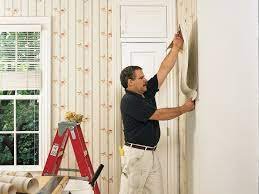Before you start installing wallpaper, there are a few things you should know:
- Make sure you understand the dimensions of the wall area where you plan to apply the wallpaper.
- Create a placement guide for yourself.
- Apply primer and adhesive.
Following these tips by wallpaper company Singapore will help you ensure a smooth wallpaper installation.
Plan ahead
When installing wallpaper, the more preparation you put into the process, the better the result; while you can always add more adhesive to the wallpaper strips during installation, it’s best to plan. Professionals recommend adding 30 per cent to the original wallpaper measurement. If you plan to use speciality patterns, consider using extra adhesive on the strips, since they’re generally more delicate than standard patterns. Also, avoid excessively high temperatures when preparing your walls for wallpaper installation. Excessive heat will dry out the pre-pasted adhesive, and the paper may curl.
If you are installing wallpaper over an old colour, it’s best to prime the walls before applying new wallpaper. This will help the paper adhere to the wall and reduce the chance of air bubbles. Also, clean the walls thoroughly with a soft brush attachment. After cleaning the walls, use a hairdryer to dry them before hanging the wallpaper.
Create a placement guide
Before beginning your wallpaper installation, creating a placement guide is essential. To do this, lightly mark the wall along the width of each strip. Next, use a pencil to draw a vertical line connecting these markings lightly. You can also use a straight edge to trace a guide for the horizontal placement of the wallpaper strips. After you’ve created the directory, measure each strip using a tape measure. Once you’ve determined the correct measurement, cut the wallpaper strips with a sharp knife.
If you’re a first-time wallpaper hanger, you should first create a plumb line on the wall. A plumb line is a line that’s vertically straight on the wall. You can use a level to draw this line or a laser level to ensure the wallpaper is level on the wall. You can also hold the wallpaper by its top edge to ensure it’s level on the wall.
Apply primer
When installing wallpaper, a good quality oil-base primer is essential. While many do-it-yourselfers and professional wallpaper installers in Singapore don’t bother priming their walls before applying wallpaper, the proper primer will help ensure an appropriate installation of wallpaper. The application of primer will help keep the wallpaper adhering to the wall, and it will also help prevent the development of mould and mildew, which can compromise the bond between the wallpaper and the wall.
After priming the wall, you should sand the wall and apply wallpaper paste. Apply the paste to the wall, starting with the minor sections. It would help if you used a thin coat, but make sure to fill in any holes and bumps.
Apply adhesive
Before applying adhesive for wallpaper installation, read the label on the wallpaper roll to determine what type of adhesive is best for your project. The title will list the type of material, weight, and adhesive requirements for each type of wallpaper. For example, metallic foil wallpaper requires a unique dispersion adhesive. Alternatively, you can use a non-woven glue or choose a structured variety to ensure that your wallpaper is entirely impervious to water.
Before you start applying adhesive, clean the walls of dirt and oil. Then, use a roller or brush to apply the wallpaper paste to the walls. When the adhesive has dried, you should smooth out the surface of the walls using sandpaper. This will make the wallpaper stick to the wall evenly without tearing or stretching.
Apply wallpaper paste
Once you’ve decided to install wallpaper, you’ll need to apply the paste to the wall, or walls, where the wallpaper will be installed. This paste will help the paper adhere to the walls and dry quickly. To apply the paste:
- Use a roller or brush.
- Carefully lay the wallpaper panel over the wall, pressing against it to push any air bubbles out of the board. Once the paper is securely laid against the wall, you can hang it.
- Avoid moving the panel while riding it, as it could tear or stretch the wallpaper or create an uneven installation.
If you’re using pre-pasted wallpaper, follow the manufacturer’s instructions. Once the wallpaper is wet, use a roller to apply the paste. Make sure to book the paste for the time specified in the instructions.
The level first piece of wallpaper
Before you begin installing wallpaper, levelling the first piece on the wall is essential. You can use a level or a laser level to do this. Once the levelling has been done, you will want to glue the wallpaper to the wall. To make sure that your wallpaper is level, hold it by the top edge while you paste it to the wall.
Start by lining the first strip of wallpaper up against the plumb line in the least-concerned area of the room. Once the wallpaper is on the wall, smooth the excess from the edges into the seam where the wall meets the ceiling. If the wallpaper has a pattern, smooth the edges of the paper from the inside out to remove wrinkles and bubbles.
Apply spackle
If your walls have been damaged during installation, you can use spackle to repair the holes and damage. Make sure to apply the spackle thoroughly and let it dry thoroughly before proceeding with the wallpaper installation. If the spackle is still visible, sand the walls to remove the texture. This will help the Korean wallpaper adhere cleanly.
If you want to use glue to stick the wallpaper down, you must prime the wall with an oil-based primer. Contact cement, oil-based primer, or a Gardz product should work well. Once the area is primed, you should apply joint compound and smooth the surface.
